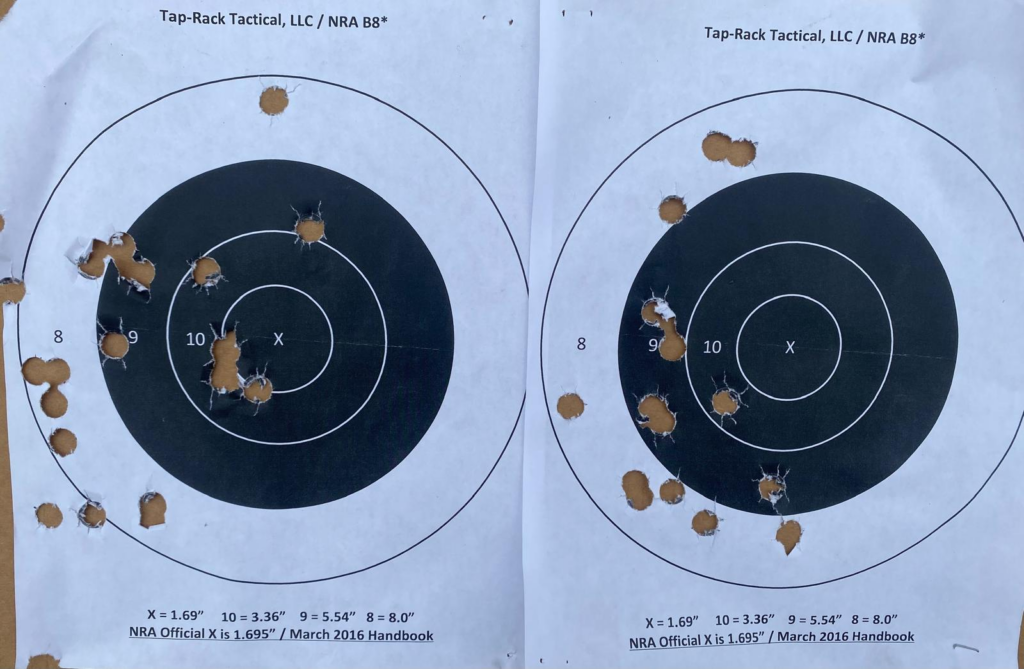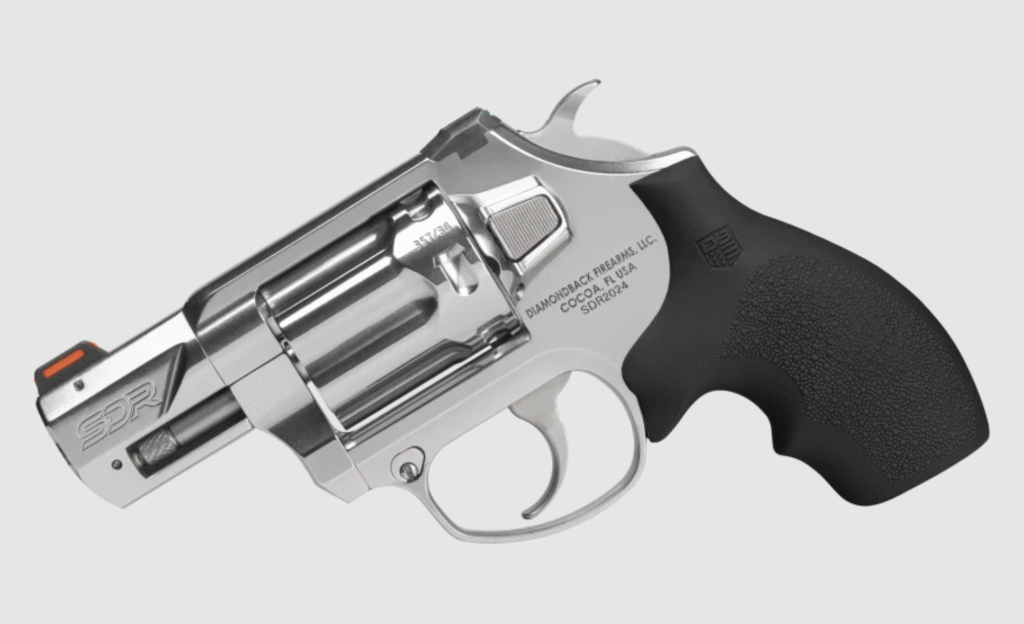The Colt Competition Series 1911 laid on the “safe table” at the gun club, prior to that Steel Challenge match.
Shooting The Colt Competition Series 1911
The Ammo Issue
I’ve tried several kinds of ammunition through this Colt, including factory-loaded 230-grain Fiocchi and PMC Bronze. All in-spec ammunition has worked fine, and like any 1911, the magazines used are a big factor. I like to use my old Wilson Combat 47D 8-rounders that I rebuilt with Tripp Spring Kits. I lost one round but gained dependable reliability.
Advertisement — Continue Reading Below
For matches, I’ve been using Wilson Combat 8-round ETMs and the lone Chip McCormick Shooting Star that came with the pistol when I first borrowed it. These are a vast improvement over the original 8-round Wilson 47Ds from 2 decades ago.
At 860 FPS, the 230-grain Fiocchi tends to be slightly warmer than average (something I’ve noticed when reviewing other .45 ACP 1911s). Even with its double recoil spring set-up, this factory ball ammo feels flippy during firing. It goes without saying that tuning a 1911 is an art and science that depends on not only the gun, a chosen load (that feeds and prints well), and a recoil spring to regulate the reciprocating motion of the slide.
Factory ammunition is designed to work reliably in a wide variety of firearms in that chambering. But that doesn’t mean that a factory load will perform optimally in a given gun. Accuracy is one thing, but the ability to recover and deliver faster-aimed splits is another, especially when things get competitive.
Advertisement — Continue Reading Below
The Classic 200-grain Sporting Load
Out of interest, enjoyment, discovery, and to get more from this Colt Competition Series, which was obviously built around modern action-pistol sports, I gravitated towards handloading one of the most classic sporting 1911 recipes out there. Specifically, a 200-grain lead semi-wadcutter based on the H&G #68 mold over 4.2 grains of Hodgdon Clays, a flaky shotgun powder that works wonderfully in .45 ACP loads.
With how long the 1911 has been around, there are no doubt countless tried and true recipes. My decision to load this one is informed by my participation in action pistol sports. In short, this load is safe for IDPA, IPSC, and USPSA and makes a major power factor easily—without the disruptive muzzle jolt of the heavier 230-grain factory ball rounds.
Besides, given how the Colt Competition Series 1911 is set up, these are the shooting disciplines the gun was designed around. In addition to that Steel Challenge match I participated in, I have every intention of shooting USPSA single-stack major with this pistol before I need to return it.
Advertisement — Continue Reading Below


When reviewing the Tisas 1911A1 ASF this past March, I also cycled another batch of these handloads when putting the pistol through its paces. The Labradar showed muzzle velocities in the 860 range. With a 200-grain bullet, this translates to 170-172 power factor, (just above the minimum of 165 PF to make major).
Advertisement — Continue Reading Below
These handloads are not only more pleasant to shoot, but with their semi wadcutter profile, they punch very crisp holes on paper targets and cardboard. Those clean holes are not only very satisfying, but they also make scoring considerably easier.
W231 Propellant
For what it’s worth, I’ve had no issues feeding these handloads across different .45-caliber pistols. In fact, I was shooting Bill Drills with that Tisas during its original review. This isn’t my first time loading this same style of 200-grain SWCs. I’ve used W231 propellant in the past. W231 is another tried-and-true powder for loading .45 ACP. However, when shooting non-coated lead bullets with this propellant, the results tend to be smokier.
While it’s cool in an old-timey way, if shooting indoor matches, it becomes a nuisance, too. Clays makes less smoke than W231, and in the before-times it was fairly affordable too. Clays is made in Canada, but the facility that manufactures it stopped producing it after the war in Ukraine began in 2022. There is no telling when it is coming back.
Advertisement — Continue Reading Below
As a bulkier flake powder, I was concerned about how precisely it would meter through the power drop in my Dillon XL750 press. While some charges are a tenth of a grain under or over, with the drop set at 4.2 grains, I’m not concerned. Considering that action-pistol shooting is relatively imprecise, I’m not concerned about accuracy deviations from that tenth of a grain either. Benchrest, this is not.
I’ve loaded nearly 965 rounds of .45 ACP with Clays and those 200-grain SWCs to date. And after sending approximately 150-175 rounds downrage between this Colt and that Tisas, I am fully confident in this “staple” recipe and my ability to craft these with my equipment.
Colt Competition Series 1911: Off The Bench And Freestyle

Advertisement — Continue Reading Below
For the sake of this article, I took this Colt out the other morning to shoot some NRA B-8 targets at 25 yards with the above-mentioned sporting handload. I don’t claim to be the best pistol shooter, but I’m happy with my results. Especially considering how long it had been since I critically shot a 1911 like this.
While shooting, the most challenging aspect was having to be as precise as possible with a center hold instead of that six o’clock hold preferred by serious bullseye shooters. Not all targets are scored, but these targets show enough of a pattern to tell a story. The left-sided bias of my groups is indicative of a different level of support hand grip tension that I keep playing around with. In the end, dots certainly make life easier too.

Advertisement — Continue Reading Below
Besides two-handed freestyle shooting, I have another friend who is very good at shooting pistols from a bench rest. They shot a 5-shot group with my handloads to see what the gun and ammo combination is capable of without the human element:

Advertisement — Continue Reading Below
Colt Competition Series 1911: The Takeaway
Colt is one of the most storied gunmakers in existence, starting with Sam Colt’s original 19th-century revolvers. When it comes to 1911 pistols, Colt’s name is symbiotic with the pistols themselves. And with such a lengthy history, fluctuations and ups and downs are inevitable.
It’s true that some vintages of Colt’s 1911s have been more desirable than others. Although the Colt Competition 1911 featured in this article predates the recent acquisition by CZ Group, this specific pistol is indicative of the brand’s comeback-making 1911s. These blued Competition Series models retail for just under $1,000. At that price, they’re not perfect, but it would be hard for me to complain about the gun’s accuracy and reliability.
For a production pistol at this pricing tier made by Colt, it’s pretty damn good. Just about the only thing the gun in this article needs is a nice trigger job. That would take it to the next level.















